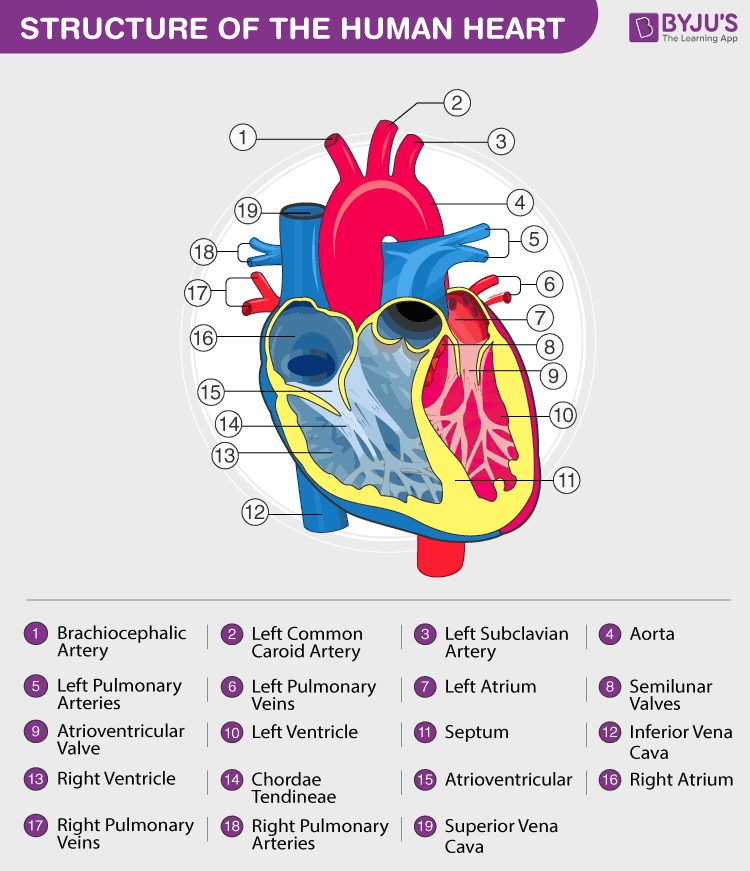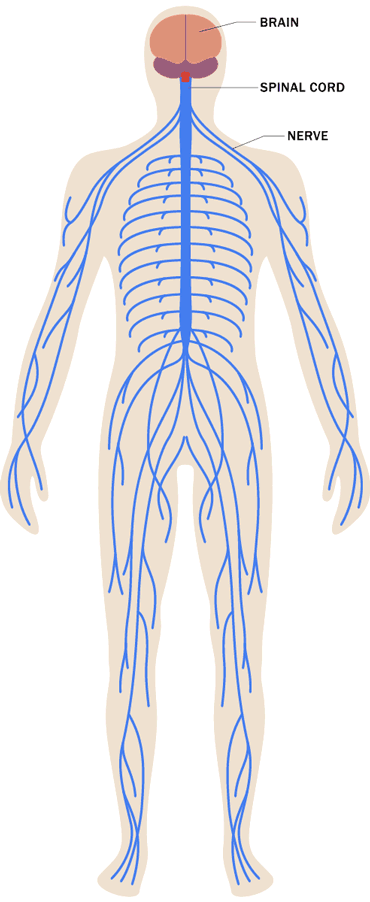45 human heart with labels and function
Heart Anatomy: Labeled Diagram, Structures, Function, and Blood Flow Let's begin with the chambers of the heart. There are 4 chambers, labeled 1-4 on the diagram below. To help simplify things, we can convert the heart into a square. We will then divide that square into 4 different boxes which will represent the 4 chambers of the heart. A Diagram of the Heart and Its Functioning Explained in Detail The heart blood flow diagram (flowchart) given below will help you to understand the pathway of blood through the heart.Initial five points denotes impure or deoxygenated blood and the last five points denotes pure or oxygenated blood. 1.Different Parts of the Body ↓ 2.Major Veins ↓ 3.Right Atrium ↓ 4.Right Ventricle ↓ 5.Pulmonary Artery ↓ 6.Lungs
Chest and the Heart Diagram & Function | Body Maps The heart is divided into four chambers: two atria and two ventricles. Blood is transported through the body via a complex network of veins and arteries. The average human heart weighs between 6 ...
Human heart with labels and function
Human Heart Diagram Labeled | Science Trends The heart's primary function is to supply the tissues of the body with oxygen and rid the body of carbon dioxide. The pulmonary circuit and the systemic circuit are the two systems of the body that enable the heart to accomplish this. Deoxygenated blood is oxygenated as leaves through the pulmonary circuit. Heart: Anatomy and Function - Cleveland Clinic Your heart is the main organ of your cardiovascular system, a network of blood vessels that pumps blood throughout your body. It also works with other body systems to control your heart rate and blood pressure. Your family history, personal health history and lifestyle all affect how well your heart works. Appointments 800.659.7822 A Labeled Diagram of the Human Heart You Really Need to See The human heart, comprises four chambers: right atrium, left atrium, right ventricle and left ventricle. The two upper chambers are called the left and the right atria, and the two lower chambers are known as the left and the right ventricles. The two atria and ventricles are separated from each other by a muscle wall called 'septum'.
Human heart with labels and function. Human Heart (Anatomy): Diagram, Function, Chambers, Location in Body The heart pumps blood through the network of arteries and veins called the cardiovascular system. The heart has four chambers: The right atrium receives blood from the veins and pumps it to the... Cross Section of the Heart Diagram & Function | Body Maps The chambers of the heart operate as a 'double-pump' system for the body's circulation. In coordination with valves, the chambers work to keep blood flowing in the proper sequence. The chambers on... Anatomy of the Human Heart - Physiopedia The heart is a muscular organ that serves to collect deoxygenated blood from all parts of the body, carries it to the lung s to be oxygenated and release carbon dioxide. Then, it transports the oxygenated blood from the lungs and distributes it to all the body parts [1] The heart pumps around 7,200 litres of blood in a day throughout the body [2]. The structure of the heart - Structure and function of the heart ... The heart is a large muscular pump and is divided into two halves - the right-hand side and the left-hand side. The right-hand side of the heart is responsible for pumping deoxygenated blood to ...
Heart - Wikipedia The heart is a muscular organ in most animals that pumps blood through the blood vessels of the circulatory system. [1] The pumped blood carries oxygen and nutrients to the body, while carrying metabolic waste such as carbon dioxide to the lungs. [2] What Are the Four Main Functions of the Heart? - MedicineNet The four main functions of the heart are: Pumping oxygenated blood to other body parts. Pumping hormones and other vital substances to different parts of the body. Receiving deoxygenated blood and carrying metabolic waste products from the body and pumping it to the lungs for oxygenation. Maintaining blood pressure. The Heart Chambers and Their Functions - GetBodySmart Blood drains into the atria from the pulmonary and systemic circulatory systems. The auricles of the heart. 1. 2. Making up the lower chambers are the right ventricle and left ventricle ( L., ventriculus, a little belly ), which are much larger than the atria. [ Anterior view / Interior view / Posterior view] Human Heart - Diagram and Anatomy of the Heart - Innerbody The heart is a muscular organ about the size of a closed fist that functions as the body's circulatory pump. It takes in deoxygenated blood through the veins and delivers it to the lungs for oxygenation before pumping it into the various arteries (which provide oxygen and nutrients to body tissues by transporting the blood throughout the body).
Labelling the heart — Science Learning Hub Labelling the heart — Science Learning Hub Labelling the heart Add to collection The heart is a muscular organ that pumps blood through the blood vessels of the circulatory system. Blood transports oxygen and nutrients to the body. It is also involved in the removal of metabolic wastes. Topics Concepts Citizen science Teacher PLD Glossary Sign in The Anatomy of the Heart, Its Structures, and Functions The heart is the organ that helps supply blood and oxygen to all parts of the body. It is divided by a partition (or septum) into two halves. The halves are, in turn, divided into four chambers. The heart is situated within the chest cavity and surrounded by a fluid-filled sac called the pericardium. Heart Diagram with Labels and Detailed Explanation - BYJUS The human heart is the most crucial organ of the human body. It pumps blood from the heart to different parts of the body and back to the heart. The most common heart attack symptoms or warning signs are chest pain, breathlessness, nausea, sweating etc. 13 parts of the human heart (and its functions) - LORECENTRAL Parts of the heart and its functions 1. Left atrium 2. Mitral Valve 3. Left Ventricle 4. Aortic sigmoid valve Right atrium 6. Tricuspid valve 7. Right ventricle 8. Pulmonary sigmoid valve 9. Atrial septal defect Interventricular partition 11. The sinus or sinoatrial node 12. Atrioventricular or Aschoff-Tawara nodule 13. Hiscules and Purkinje fibers
Parts Of The Human Heart | Science Trends But few people know all its parts and their essential functions. Broadly speaking, the human heart has one function: to pump blood through the circulatory system all throughout the body, thus supplying both nutrients and oxygen to the body's tissues while also removing all the wastes, including carbon dioxide. The Anatomy of the Human Heart
Free Heart Worksheets for Human Anatomy Lessons The human heart is a strong muscular organ. It's responsible for pumping blood throughout the body. It's located behind and slightly to the left of the breastbone and is about the size of a fist. The heart brings oxygen-rich blood and nutrients to the cells and allows the body to remove the waste product and carbon dioxide from the cells.
Human Heart - Anatomy and Functions | Location and Chambers - VEDANTU The human heart is the organ that pumps blood throughout the body via the vessels of the circulatory system, supplying oxygen and nutrients to the tissues and removing carbon dioxide and other wastes. Pumping the blood through the arteries, capillaries, and veins is the major function of the heart. It maintains proper circulation of blood.
Human heart: Anatomy, function & facts | Live Science The human heart is located in the center of the chest - slightly to the left of the sternum (breastbone). It sits between your lungs and is encased in a double-walled sac called the pericardium,...
heart | Structure, Function, Diagram, Anatomy, & Facts | Britannica In humans and other mammals and in birds, the heart is a four-chambered double pump that is the centre of the circulatory system. In humans it is situated between the two lungs and slightly to the left of centre, behind the breastbone; it rests on the diaphragm, the muscular partition between the chest and the abdominal cavity. Britannica Quiz
The Heart - Science Quiz - GeoGuessr This science quiz game will help you identify the parts of the human heart with ease. Blood comes in through veins and exists via arteries—to control the direction of the flow, the heart has four sets of valves. The heart is an amazing machine with a lot of moving parts—let this quiz game help you find your way around this most vital of organs.
The 18 parts of the human heart, and their functions The 18 parts of the human heart and how they work 1. Myocardium 2. Endocardium 3. Pericardium 4. Right Auricle 5. Right ventricle 6. Tricuspid valve 7. Pulmonary valve 8. Left Auricle 9. Left ventricle 10. Mitral valve 11. Aortic valve 12. Tendon cords 13. Papillary muscles 14. Sinus node 15. Atrioventricular node 16. Atrioventricular fascicule 17.
Label the heart — Science Learning Hub In this interactive, you can label parts of the human heart. Drag and drop the text labels onto the boxes next to the heart diagram. If you want to redo an answer, click on the box and the answer will go back to the top so you can move it to another box. If you want to check your answers, use the Reset Incorrect button.
Human Heart - Anatomy, Functions and Facts about Heart Following are the main functions of the heart: One of the primary functions of the human heart is to pump blood throughout the body. Blood delivers oxygen, hormones, glucose and other components to various parts of the body, including the human heart. The heart also ensures that adequate blood pressure is maintained in the body
Heart Diagram - 15+ Free Printable Word, Excel, EPS, PSD Template ... Teachers and students use the heart diagram, in biological science, to study the structure and functions of a human being's heart. ... Label The Parts Of The Heart. depts.washington.edu | Having the heart diagram for studies or for scientific purpose has been made easy through this template. It shows a heart picture with all its parts labeled ...
A Labeled Diagram of the Human Heart You Really Need to See The human heart, comprises four chambers: right atrium, left atrium, right ventricle and left ventricle. The two upper chambers are called the left and the right atria, and the two lower chambers are known as the left and the right ventricles. The two atria and ventricles are separated from each other by a muscle wall called 'septum'.
Heart: Anatomy and Function - Cleveland Clinic Your heart is the main organ of your cardiovascular system, a network of blood vessels that pumps blood throughout your body. It also works with other body systems to control your heart rate and blood pressure. Your family history, personal health history and lifestyle all affect how well your heart works. Appointments 800.659.7822
Human Heart Diagram Labeled | Science Trends The heart's primary function is to supply the tissues of the body with oxygen and rid the body of carbon dioxide. The pulmonary circuit and the systemic circuit are the two systems of the body that enable the heart to accomplish this. Deoxygenated blood is oxygenated as leaves through the pulmonary circuit.







![BIOMED ALL INVITED: The Human Heart [ANATOMY/PHYSIOLOGY/CONDUCTION SYSTEM]](https://blogger.googleusercontent.com/img/b/R29vZ2xl/AVvXsEilwWG9VE7RxwxzTGtCdLWDzuAnNDiEuUwyZTpA78irzLBNb1vfVYzTwTkevB5Ph3WI4qnVhE4H7K-iC5u4wyIBDVj734FmD5wfm5Y25oOzsVzVeCd3vBHmFIJn0bIo0U8z1R2cWNoHEyMJ/s1600/heart+anatomy.jpg)



/circulatory_system-56e73fe45f9b5854a9f962fc.jpg)

Post a Comment for "45 human heart with labels and function"